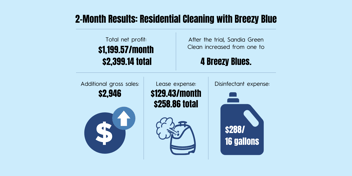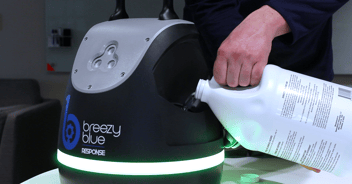
Deodorizing Made Easy with Aerosolized Hydrogen Peroxide
Discover an effective and convenient method of deodorizing with Aerosolized Hydrogen Peroxide (aHP) that eliminates odors at their source.
Understanding the Source of Indoor Odors
Indoor odors can originate from various sources, including cooking activities, pets, tobacco smoke, mold and mildew growth, household cleaning products, and more. It's important to understand the source of these odors in order to effectively eliminate them. By identifying the root cause, you can take the necessary steps to address the problem and prevent odors from recurring. Whether it's a musty smell from a damp basement or the lingering scent of last night's dinner, knowing where the odor is coming from is the first step in deodorizing your space.
Indoor odors can generally be separated into two main categories: chemical and organic. Chemical odors arise from synthetic substances, such as household cleaning products, paints, and many air fresheners. These odors often have a distinct, sometimes overpowering, artificial scent. On the other hand, organic odors are derived from natural sources, like cooking activities, pet dander, and mold. Organic odors tend to be more diverse and can range from pleasant to putrid.
Volatile Organic Compounds (VOCs) are another potential source of indoor odors and can also have health implications. As explained by the EPA, VOCs are a group of organic chemicals that can evaporate into the air at room temperature. They originate from various sources, both natural and synthetic. Examples include benzene, formaldehyde, and ethylene glycol (anti-freeze). Common indoor sources of VOCs include household cleaning products, paints, solvents, adhesives, and certain building materials. While not all VOCs are harmful, some can have adverse health effects such as respiratory irritation, headaches, and eye or skin irritation.
Masking Over Versus Eliminating Odors
Masking over odors is a temporary solution that involves using air fresheners, sprays, or scented candles to cover up unpleasant smells. While masking agents can provide a quick remedy and make the environment more pleasant temporarily, they do not eliminate the underlying cause. And over time, masking can lead to the accumulation of fragrances within the indoor air, and potentially produce unhealthy air components such as VOCs.
Eliminating the odor at its source is considered the best approach to achieve long-lasting and effective odor control. This involves identifying the root cause of the smell and taking measures to address it directly. For instance, if cooking odors are the issue, using exhaust fans and maintaining a clean kitchen can help eliminate the source of the smell. Similarly, addressing pet odors may involve regular pet grooming and cleaning of pet bedding. Another way to eliminate organic odors is neutralizing organic matter with an oxidizer such as aerosolized hydrogen peroxide (aHP). By breaking down the molecules that cause organic odors and VOCs, the oxidizer neutralizes the source leaving a space truly odor free.
Benefits of Deodorizing with aHP
For thorough deodorizing of large spaces or hard to clean surfaces such as carpets and fabrics, fogging with aerosolized hydrogen peroxide (aHP) is a highly effective solution for eliminating a wide range of odors, from pet smells to musty mildew odors. When aerosolized, hydrogen peroxide molecules are carried throughout the indoor environment, neutralizing pollutants and contaminants on surfaces, in the air, and in places that are difficult to reach. Additionally, hydrogen peroxide has been shown to accelerate the absorption and breakdown of VOCs1,2.
And aHP is a safe and environmentally friendly option for broad and thorough deodorization. When aerosolized, the hydrogen peroxide (H2O2) rapidly and safely breaks down into oxygen gas (O2) and water vapor (H2O) as part of the oxidation process that neutralizes contaminants. Hydrogen peroxide is odorless, colorless and leaves zero residue or byproducts.
Step-by-Step Guide to Deodorizing with aHP
Aerosolized hydrogen peroxide (aHP) can be applied within a commercial or residential space with equipment such as the Breezy Blue smart fogger, which is easy to use and requires minimal time and effort. With Breezy Blue, you can deodorize using this simple four-step process.
1. Prepare the space: Remove any items or debris that may be contributing to the odor. Remove any pets or people from the space.
2. Apply the aHP: place the Breezy Blue fogger within the doorway of the space to be deodorized, and use the push button to start the fogging (Breezy Blue's fogging duration is programable, and one minute of fogging is adequate for a typical 1000 sq. ft. room).
3. Let the fog settle: After the fogging stops, close the door and leave the space undisturbed for 10 minutes to allow sufficient contact time and penetration to neutralize any odor-causing organic material.
4. Exhaust or let evaporate naturally: After 10 minutes of contact time, you can open the door to exhaust any remaining hydrogen peroxide, or if you do nothing, the hydrogen peroxide will naturally and safely break down into oxygen gas and water vapor in about 30 minutes.
By following these simple steps, you can effectively deodorize your space using aerosolized hydrogen peroxide (aHP). In conclusion, understanding the sources of indoor odors is essential for devising effective strategies for odor control. Eliminating odors at their source, through targeted actions, offers a more sustainable solution compared to merely masking over the smells with artificial fragrances. Taking a proactive approach to indoor air quality contributes to a healthier living space and enhances overall well-being.
References:
- Richard B. Lawson & Craig D. Adams (1999) Enhanced VOC Absorption Using the Ozone/Hydrogen Peroxide Advanced Oxidation Process, Journal of the Air & Waste Management Association, 49:11, 1315-1323, DOI: 10.1080/10473289.1999.10463959
- Al Martinez, et al. (1993) Using hydrogen peroxide or ozone to enhance the incineration of volatile organic vapors, Waste Management, 13:3, 261-270, DOI: 10.1016/0956-053X(93)90050-7
Subscribe to Our Newsletter for More




